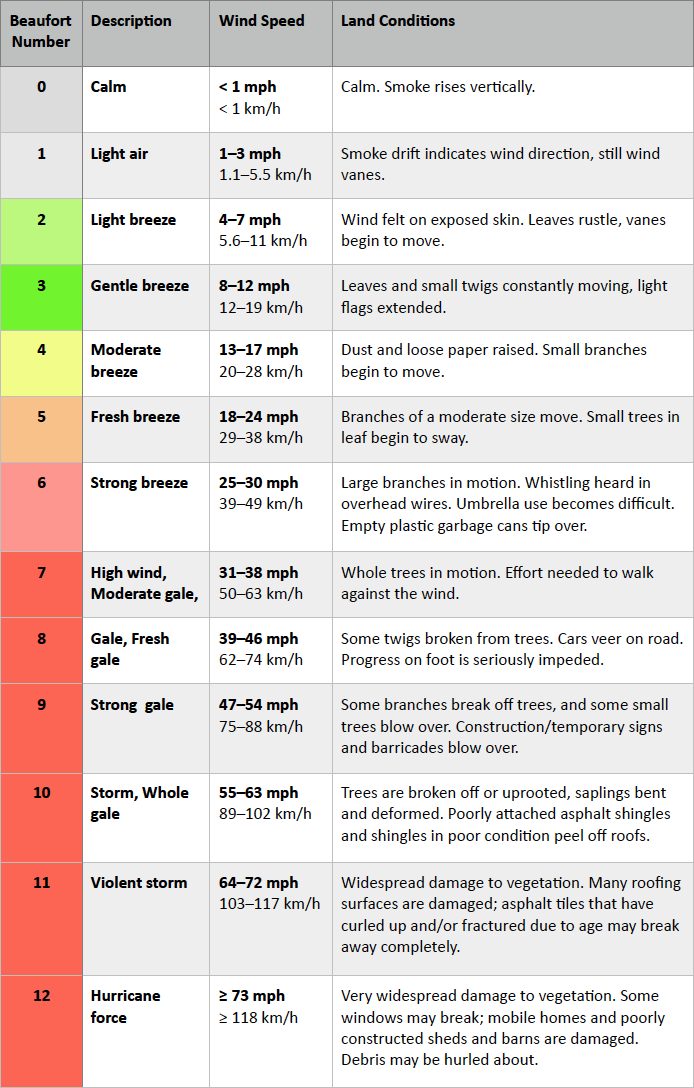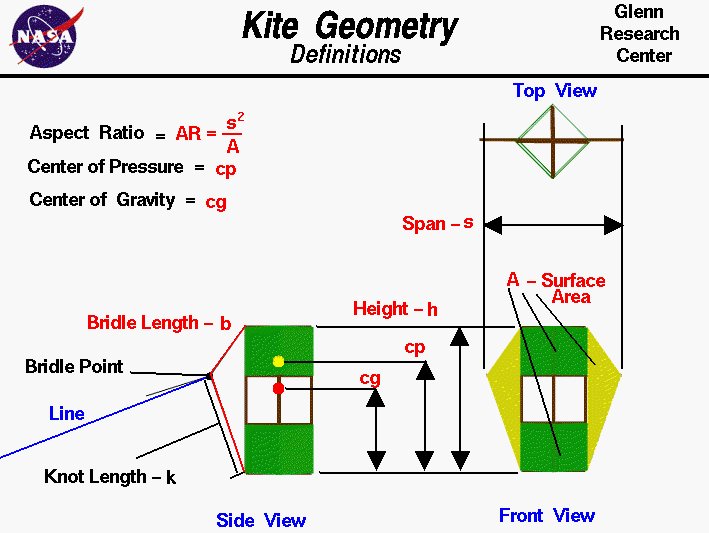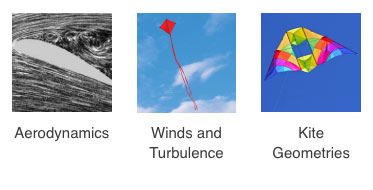Aerodynamics
There are four forces that act on a kite in flight:
- Lift- the force that acts in the opposite direction of the ground. It must overcome the weight of the kite and the force of gravity for the kite to fly.
- Drag- the force of wind pushing on the kite. Drag is a type of friction that depends on both the velocity and density of the wind.
- Weight- the force that pulls the kite towards the ground and is made up in part by gravity.
- Pull- the force of tension on the kite line. Pull keeps the kite from being pulled by the wind.
When the kite is in stable flight, the forces remain constant and there is no net external force acting on the kite, according to Newton’s first law of motion. In the vertical direction, the sum of the forces is zero. Therefore, the vertical pull plus the weight minus the lift equals zero.
Pv + W – L = 0
In the horizontal direction, the sum of the horizontal pull and the drag must also equal zero.
Ph – D = 0

Wind and Turbulence
Wind is the flow of air on a large scale caused by differences in atmospheric pressure. It’s characterized in meteorology by velocity and density. When a difference in atmospheric pressure exists, air moves from the higher to the lower pressure area, resulting in winds of various speeds. Wind occurs on a range of scales, from thunderstorm flows lasting tens of minutes, to local breezes generated by heating of land surfaces and lasting a few hours, to global winds resulting from the difference in absorption of solar energy between the climate zones on Earth. The two main causes of large-scale atmospheric circulation are the differential heating between the equator and the poles, and the rotation of the planet (Coriolis effect). One way to characterize wind speeds is with the Beaufort Scale that associates wind ranges with the effect on the local land condition.
Air turbulence is when bodies of air moving at widely different speeds meet and there are several different phenomenon that cause it. Mechanical turbulence is cause when friction between the air and the ground, especially irregular terrain and man-made obstacles, cause eddies. The intensity of this eddy motion depends on the strength of the surface wind, the nature of the surface and the stability of the air. The stronger the wind speed, the rougher the terrain and the more unstable the air, the greater the turbulence. In strong winds, even hangars and large buildings cause eddies that can be carried some distance downwind.Appropriate wind conditions are crucial for successful kite flying. Most kites come labeled with an ideal wind range that is safe and appropriate for that specific kite. Flying in speeds under the ideal wind range means the kite will not be able to generate enough lift to fly, and above the wind range the kite will fly erratically and can become dangerous to the flyer.

Thermal Turbulence can be expected on warm summer days when the sun heats the earth’s surface unevenly. Certain surfaces, such as barren ground, rocky and sandy areas, are heated more rapidly than are grass covered fields and much more rapidly than is water. Isolated convective currents are therefore set in motion with warm air rising and cooler air descending, which are responsible for bumpy conditions as an airplane flies in and out of them. Thermal turbulence extends from the base to the top of the convection layer, with smooth conditions found above.
Frontal Turbulence is the lifting of the warm air by the sloping frontal surface and friction between the two opposing air masses in the frontal zone. This turbulence is most marked when the warm air is moist and unstable and will be extremely severe if thunderstorms develop. Turbulence is more commonly associated with cold fronts but can be present, to a lesser degree, in a warm front as well.
Lastly, Wind Shear is the change in wind direction and/or wind speed over a specific horizontal or vertical distance. Atmospheric conditions where wind shear exists include: areas of temperature inversions, along troughs and lows, and around jet stream. When the change in wind speed and direction is pronounced, quite severe turbulence can be expected. Temperature inversions are zones with vertical wind shear potential. Strong stability prevents mixing of the stable low layer with the warmer layer above. The greatest shear, and thus the greatest turbulence, is found at the tops of the inversion layer. Turbulence associated with temperature inversions often occur due to radiational cooling, which is nighttime cooling of the Earth’s surface, creating a surface-based inversion.
Kite Geometries
The image above shows a three view diagram of a winged box kite. Beginning with the Front View, we note that the surface area-A which is used in the calculation of lift and drag is the frontal projected area of all of the surfaces of the kite. You learn how to compute the area of various shaped objects in middle school. For this winged box kite, the frontal projected area includes the full area of both wings (colored yellow) and the projected area of the top and bottom boxes (colored green). Notice that this is a projected area, not a geometric area. If each panel of the box kite is a square, there are four panels on the top and four on the bottom to form the two boxes.
From the Top View, we see that each panel is inclined to the front at a 45 degree angle. Then the projected area Ap of each panel is equal to the geometric area Ag times the cosine cos of 45 degrees:
Ap = Ag * cos(45 degrees) = .707 * Ag

If the geometric area is slanted to the front then the frontal projected area is always less than the geomtric area. The top and front view also help us define the span-s of the kite. The span is the widest distance from side to side. It is the same as thewing span of an airplane, the distance from one wing tip to the other wing tip. The ratio of the square of the span to the area A is called the Aspect Ratio AR of the kite.
AR = s^2 / A
This parameter is very important in the determination of lift and drag of the kite. Airplane wings typically have a very long span and have a high aspect ratio. Kites on the other hand usually have a small span and are low aspect ratio aircraft. High aspect ratio aircraft have a higher lift to drag ratio than a low aspect ratio aircraft and are more aerodynamically efficient.
The Side View helps us locate the center of gravity-cg and the center of pressure-cp of the kite. The center of gravity is the average location of the weight of the kite, and the weight force acts through this point. Similarly, the center of pressure is the average location of the aerodynamic forces on the kite, and the lift and drag act through this point. There are techniques to determine the weight, cg, and cp which are described on separate pages.
On the front of the kite (to the left in this side view) we attach a bridle string. The bridle length-b is the length of the string from one end attached to the top to the other end attached to the bottom of our kite. It is always longer than the height-h of the kite, so there is some slack in this string. A knot is used to attach the control line to the bridle at a spot called the bridle point. The knot length-k is the distance from the bottom to the knot along the bridle string. The knot length and the bridle length determine the location of the bridle point. In flight, the kite rotates about the bridle point. A kite’s stability is determined by the magnitude of the forces and the distance of the cg and cp from the bridle point.









